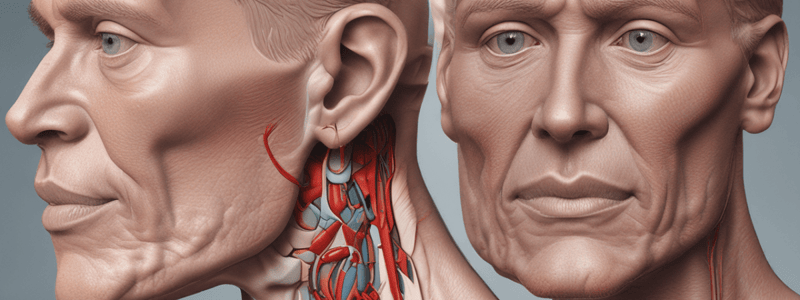Podcast
Questions and Answers
What type of saliva does the parotid gland produce?
What type of saliva does the parotid gland produce?
- Saline saliva
- Mucous saliva
- Serous saliva (correct)
- Thick saliva
Which structure anatomically separates the deep and superficial lobes of the parotid gland?
Which structure anatomically separates the deep and superficial lobes of the parotid gland?
- Facial nerve (correct)
- Stensen duct
- Buccinator muscle
- Masseter muscle
Where does the Stensen duct open into the oral cavity?
Where does the Stensen duct open into the oral cavity?
- Near the third lower molar
- Near the second upper molar (correct)
- Near the first upper molar
- Near the first lower molar
Which artery gives rise to the posterior auricular artery within the parotid gland?
Which artery gives rise to the posterior auricular artery within the parotid gland?
What structures bound the parotid region anteriorly?
What structures bound the parotid region anteriorly?
Which gland is found in the parotid region?
Which gland is found in the parotid region?
Which nerve delivers sensory innervation to the parotid gland?
Which nerve delivers sensory innervation to the parotid gland?
What is the origin of sympathetic innervation to the parotid gland?
What is the origin of sympathetic innervation to the parotid gland?
What effect does parasympathetic innervation have on the parotid gland?
What effect does parasympathetic innervation have on the parotid gland?
What is the major site of salivary gland tumors?
What is the major site of salivary gland tumors?
What is the procedure known as when the parotid gland and tumor are surgically removed?
What is the procedure known as when the parotid gland and tumor are surgically removed?
What can happen if the facial nerve or its branches are damaged during a parotidectomy?
What can happen if the facial nerve or its branches are damaged during a parotidectomy?
Flashcards are hidden until you start studying
Study Notes
The Parotid Region
The parotid region is the site of the parotid gland, a bilateral salivary gland located in the face. This gland produces serous saliva, a watery solution rich in enzymes, which is then secreted into the oral cavity, where it lubricates and aids in the breakdown of food. The parotid region is anatomically bound by the zygomatic arch superiorly, the inferior border of the mandible inferiorly, the masseter muscle anteriorly, and the external ear and sternocleidomastoid posteriorly.
The parotid gland itself is divided into deep and superficial lobes, which are separated by the facial nerve. It lies within a deep hollow, known as the parotid region. The secretions of the parotid gland are transported to the oral cavity by the Stensen duct, which arises from the anterior surface of the gland, traverses the masseter muscle, pierces the buccinator, and opens out into the oral cavity near the second upper molar.
Anatomical Relationships
The parotid gland has several important neurovascular structures passing through it. The facial nerve (CN VII) gives rise to five terminal branches within the parotid gland, innervating the muscles of facial expression. The external carotid artery gives rise to the posterior auricular artery within the parotid gland, and it then divides into its two terminal branches, the maxillary artery and superficial temporal artery. The retromandibular vein is formed within the parotid gland by the convergence of the superficial temporal and maxillary veins, and it is one of the major structures responsible for venous drainage of the face.
The parotid gland also has a complex innervation system. It receives sensory and autonomic innervation. The autonomic innervation controls the rate of saliva production, while the sensory innervation is supplied by the auriculotemporal nerve and the great auricular nerve. The parasympathetic innervation to the parotid gland begins with the glossopharyngeal nerve (cranial nerve IX), which synapses with the otic ganglion, a collection of neuronal cell bodies. The auriculotemporal nerve then carries parasympathetic fibers from the otic ganglion to the parotid gland, causing an increase in saliva production upon stimulation. Sympathetic innervation originates from the superior cervical ganglion, part of the paravertebral chain, and fibers from this ganglion travel along the external carotid artery to reach the parotid gland, inhibiting saliva secretion via vasoconstriction.
Clinical Relevance: Disorders of the Parotid Gland
The parotid gland is the most common site of a salivary gland tumor. These tumors are usually benign, such as an adenolymphoma. In contrast, tumors of the submandibular and sublingual glands are less common but more likely to be malignant. Treatment usually involves surgical excision of the tumor and parotid gland, known as a parotidectomy. During this procedure, it is critical to identify and preserve the facial nerve and its branches, as damage to the facial nerve or its branches will cause paralysis of the facial muscles. The affected muscles will lose tone, and the area will 'sag', particularly the inferior eyelid.
Studying That Suits You
Use AI to generate personalized quizzes and flashcards to suit your learning preferences.




